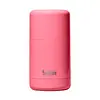What's inside
What's inside
 Key Ingredients
Key Ingredients

 Benefits
Benefits

 Concerns
Concerns

 Ingredients Side-by-side
Ingredients Side-by-side

Water
Skin ConditioningPropanediol
SolventMandelic Acid
AntimicrobialPolysorbate 20
EmulsifyingGlycerin
HumectantGluconolactone
Skin ConditioningLactic Acid
BufferingNiacinamide
SmoothingXylityl Sesquicaprylate
AntimicrobialAnhydroxylitol
HumectantPanthenol
Skin ConditioningPotassium Hydroxide
BufferingParfum
MaskingHydroxyethylcellulose
Emulsion StabilisingSodium Benzoate
MaskingCitric Acid
BufferingSodium Phytate
Benzoic Acid
MaskingCoumarin
PerfumingLimonene
PerfumingHexyl Cinnamal
PerfumingWater, Propanediol, Mandelic Acid, Polysorbate 20, Glycerin, Gluconolactone, Lactic Acid, Niacinamide, Xylityl Sesquicaprylate, Anhydroxylitol, Panthenol, Potassium Hydroxide, Parfum, Hydroxyethylcellulose, Sodium Benzoate, Citric Acid, Sodium Phytate, Benzoic Acid, Coumarin, Limonene, Hexyl Cinnamal
Caprylic/Capric Triglyceride
MaskingOzokerite
Emulsion StabilisingMaranta Arundinacea Root Powder
Skin ConditioningParfum
MaskingZinc Ricinoleate
Salicylic Acid
MaskingAscophyllum Nodosum Extract
Skin ConditioningLaminaria Digitata Extract
Skin ProtectingCalophyllum Inophyllum Seed Oil
AntimicrobialSaccharomyces Ferment
Skin ConditioningLauroyl Lysine
Skin ConditioningGlycerin
HumectantCocos Nucifera Oil
MaskingButyrospermum Parkii Butter
Skin ConditioningLimonene
PerfumingCoumarin
PerfumingHexyl Cinnamal
PerfumingCaprylic/Capric Triglyceride, Ozokerite, Maranta Arundinacea Root Powder, Parfum, Zinc Ricinoleate, Salicylic Acid, Ascophyllum Nodosum Extract, Laminaria Digitata Extract, Calophyllum Inophyllum Seed Oil, Saccharomyces Ferment, Lauroyl Lysine, Glycerin, Cocos Nucifera Oil, Butyrospermum Parkii Butter, Limonene, Coumarin, Hexyl Cinnamal
 Reviews
Reviews

Ingredients Explained
These ingredients are found in both products.
Ingredients higher up in an ingredient list are typically present in a larger amount.
Coumarins are a group of substances found naturally in plants. There are over 1300 types of coumarins identified. It has a natural vanilla scent.
Coumarin is an identified EU known allergy, meaning it may cause an allergic reaction when applied to the skin.
In many countries, coumarin is banned as a food additive. However, it can be found in soaps, tobacco products, and some alcohol drinks.
Plants use coumarins as a chemical defense. Some plants that have coumarins include lavender, tonka beans, and yellow clovers.
Learn more about CoumarinGlycerin is already naturally found in your skin. It helps moisturize and protect your skin.
A study from 2016 found glycerin to be more effective as a humectant than AHAs and hyaluronic acid.
As a humectant, it helps the skin stay hydrated by pulling moisture to your skin. The low molecular weight of glycerin allows it to pull moisture into the deeper layers of your skin.
Hydrated skin improves your skin barrier; Your skin barrier helps protect against irritants and bacteria.
Glycerin has also been found to have antimicrobial and antiviral properties. Due to these properties, glycerin is often used in wound and burn treatments.
In cosmetics, glycerin is usually derived from plants such as soybean or palm. However, it can also be sourced from animals, such as tallow or animal fat.
This ingredient is organic, colorless, odorless, and non-toxic.
Glycerin is the name for this ingredient in American English. British English uses Glycerol/Glycerine.
Learn more about GlycerinHexyl Cinnamal is a fragrance ingredient with a similar scent to jasmine. It can be naturally found in chamomile essential oil.
This ingredient is a known EU allergen and may sensitize the skin. The EU requires this ingredient to be listed separately on an ingredients list.
Hexyl Cinnamal is not water soluble but is soluble in oils.
Learn more about Hexyl CinnamalLimonene is a fragrance that adds scent and taste to a formulation.
It's found in the peel oil of citrus fruits and other plants such as lavender and eucalyptus. The scent of limonene is generally described as "sweet citrus".
Limonene acts as an antioxidant, meaning it helps neutralize free radicals.
When exposed to air, oxidized limonene may sensitize the skin. Because of this, limonene is often avoided by people with sensitive skin.
The term 'fragrance' is not regulated in many countries. In many cases, it is up to the brand to define this term. For instance, many brands choose to label themselves as "fragrance-free" because they are not using synthetic fragrances. However, their products may still contain ingredients such as essential oils that are considered a fragrance.
Learn more about LimoneneParfum is a catch-all term for an ingredient or more that is used to give a scent to products.
Also called "fragrance", this ingredient can be a blend of hundreds of chemicals or plant oils. This means every product with "fragrance" or "parfum" in the ingredients list is a different mixture.
For instance, Habanolide is a proprietary trade name for a specific aroma chemical. When used as a fragrance ingredient in cosmetics, most aroma chemicals fall under the broad labeling category of “FRAGRANCE” or “PARFUM” according to EU and US regulations.
The term 'parfum' or 'fragrance' is not regulated in many countries. In many cases, it is up to the brand to define this term.
For instance, many brands choose to label themselves as "fragrance-free" because they are not using synthetic fragrances. However, their products may still contain ingredients such as essential oils that are considered a fragrance by INCI standards.
One example is Calendula flower extract. Calendula is an essential oil that still imparts a scent or 'fragrance'.
Depending on the blend, the ingredients in the mixture can cause allergies and sensitivities on the skin. Some ingredients that are known EU allergens include linalool and citronellol.
Parfum can also be used to mask or cover an unpleasant scent.
The bottom line is: not all fragrances/parfum/ingredients are created equally. If you are worried about fragrances, we recommend taking a closer look at an ingredient. And of course, we always recommend speaking with a professional.
Learn more about Parfum